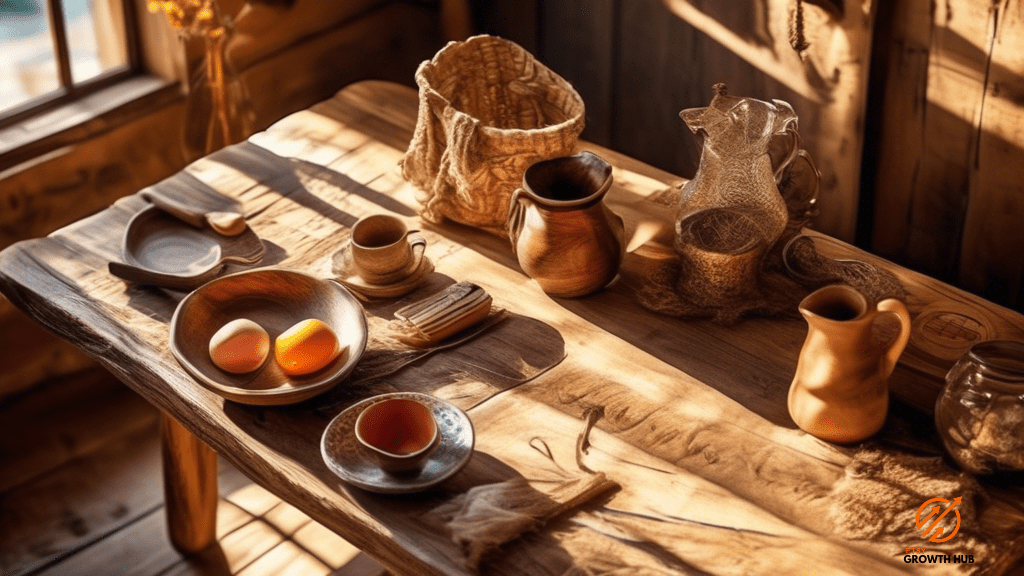How To Price Your Handmade Products Competitively
by Kevin Fairbanks · February 8, 2024
Discover the secrets to competitive pricing for your handmade products and boost your profits. Don’t miss out on our expert tips on how to attract customers and maximize your sales. Take a step towards success today!
Are you an artist or crafter looking to sell your handmade products? Do you often find yourself wondering how to price your creations in a way that is both competitive and profitable?
Look no further! In this article, we will guide you through the process of pricing your handmade products competitively, ensuring that you not only cover your costs but also make a profit.
In order to price your handmade products competitively, it is important to start by identifying your costs. This includes not only the cost of materials used in creating your products but also any overhead expenses such as packaging, shipping, and marketing. By understanding your costs, you can set a baseline price that ensures you are not selling your products at a loss.
Next, it is crucial to research the market to determine a competitive price range for your handmade products. Look at similar products being sold by other artists and crafters to get an idea of what customers are willing to pay. This will help you position your prices in a way that is attractive to potential buyers while still allowing you to make a profit.
Key Takeaways
- Identify and consider all costs of materials and overhead expenses when determining pricing for handmade products.
- Research the market to determine a competitive price range and understand customer preferences and competitor pricing.
- Calculate the total cost per product and desired profit margin to determine the minimum selling price.
- Adjust prices for seasonal demand based on supply, demand, and market trends, taking into account any additional production costs or changes in labor requirements.
Identifying Your Costs
Now that you know the importance of identifying your costs, let’s dive deeper into how you can determine the price for your handmade products.
The first step is to identify all the costs associated with creating your products. This includes the cost of materials, such as fabrics, beads, or paints, as well as any tools or equipment you use. Don’t forget to also consider any packaging or shipping materials you need to purchase. It’s important to be thorough in this process to ensure that you are accurately accounting for all your expenses.
Once you have identified your costs, you can calculate your total cost per product. This involves adding up all the costs associated with creating one unit of your product. For example, if you’re making jewelry, you would include the cost of the materials, any findings or clasps, and the packaging materials.
This total cost per product will serve as your baseline for determining the price.
In addition to covering your costs, you also need to consider your desired profit margin. This is the amount of money you want to make on each sale. It’s important to be realistic and consider factors such as market demand and competition when setting your profit margin.
Once you have determined your desired profit margin, you can add it to your total cost per product to determine the final price for your handmade products. Remember, pricing your products competitively involves finding the right balance between covering your costs and making a profit, while also remaining attractive to potential customers.
Researching the Market
Surprisingly, researching the market can reveal valuable insights for pricing your one-of-a-kind creations. By understanding the market demand and competition, you can set a competitive price that not only covers your costs but also attracts customers.
Here are three key reasons why market research is essential for pricing your handmade products:
- Understanding customer preferences: Researching the market allows you to gain insights into what customers are looking for and what they’re willing to pay. By analyzing trends, customer reviews, and competitor offerings, you can identify the features and qualities that are most valued by your target audience. This knowledge can help you position your products effectively and price them accordingly.
- Evaluating competitor pricing: Examining the pricing strategies of your competitors can give you a benchmark for setting your own prices. Take note of their pricing ranges, discounts, and promotions to gauge how you can differentiate yourself in the market. If your products offer unique features or superior craftsmanship, you may be able to justify a higher price point. On the other hand, if competitors are pricing their similar products lower, you may need to find other ways to add value or consider adjusting your pricing strategy.
- Identifying market gaps: Through market research, you can identify gaps or niches in the market where your handmade products can stand out. Look for areas where demand outweighs supply, or where there are limited options available to customers. By targeting these gaps, you can position your products as a unique and desirable choice, allowing you to price them accordingly. Additionally, understanding the market gaps can also help you identify potential new product ideas or variations that can further differentiate your offerings.
In conclusion, researching the market is crucial when pricing your handmade products competitively. By understanding customer preferences, evaluating competitor pricing, and identifying market gaps, you can set a price that not only covers your costs but also appeals to your target audience. Take the time to gather data and analyze the market to ensure you’re making informed pricing decisions for your one-of-a-kind creations.
Calculating Your Profit Margin
To ensure a competitive edge, you’ll need to calculate the profit margin of your handmade items. This is an important step in determining the price at which you should sell your products.
To calculate your profit margin, you’ll first need to determine the total cost of producing your item. This includes the cost of materials, labor, and any other expenses involved in the production process.
Once you have determined your total cost, you can then calculate your profit margin by subtracting your total cost from the selling price of your item. For example, if your total cost is $10 and you sell your item for $20, your profit margin would be $10. This means that you are making a 50% profit on each item sold.
Calculating your profit margin is crucial for pricing your handmade products competitively. It allows you to determine the minimum price at which you should sell your items in order to cover your costs and make a profit.
Additionally, by knowing your profit margin, you can also adjust your pricing strategy to ensure that you’re offering a competitive price compared to other sellers in the market.
Considering Value-added Features
Adding value-added features to your handmade products can greatly enhance their market appeal and give you a competitive edge. These additional features not only make your products stand out from the competition, but they also add perceived value to your customers. By offering something extra that other sellers may not have, you can justify charging a higher price for your handmade products.
One effective way to showcase the value-added features of your handmade products is by using a table to highlight the unique qualities and benefits they offer. Here is an example of a table that you can incorporate into your product descriptions:
| Feature | Benefit | Price Increase |
|---|---|---|
| Hand-painted design | One-of-a-kind product | +$10 |
| Premium materials | Higher quality and durability | +$15 |
| Personalized customization | Unique and tailored to customer’s preferences | +$20 |
| Eco-friendly packaging | Environmentally conscious choice | +$5 |
| Free gift wrapping | Convenient and thoughtful service | +$3 |
By clearly outlining the value-added features and the corresponding benefits, customers can easily see why your handmade products are worth the higher price. This table format allows them to compare and evaluate the added value they will receive, ultimately making them more willing to pay a premium for your products. Remember to continuously assess and update the value-added features you offer to stay ahead of the competition and keep your pricing competitive.
Adjusting Prices for Seasonal Demand
When adjusting prices for seasonal demand, you’ll want to consider factors such as supply and demand fluctuations, market trends, and the impact on your production costs. By taking these factors into account, you can ensure that your handmade products are priced competitively and attract customers during peak seasons.
Here are some key points to consider when adjusting prices for seasonal demand:
- Supply and demand fluctuations: During certain times of the year, the demand for certain handmade products may increase or decrease. It’s important to monitor these fluctuations and adjust your prices accordingly.
For example, if the demand for your handmade scarves increases during the winter months, you may consider raising the prices slightly to capitalize on the higher demand.
- Market trends: Stay up-to-date on the latest market trends to understand what customers are looking for during different seasons. This can help you determine which products are in high demand and adjust your prices accordingly.
For instance, if there is a growing trend for eco-friendly products during the spring season, you may consider increasing the prices of your handmade eco-friendly items to reflect their value in the market.
- Impact on production costs: Seasonal demand can also impact your production costs. For example, if you need to source materials that are more expensive during certain seasons, you may need to adjust your prices to cover these higher costs.
Additionally, if you experience an increase in demand that requires you to hire additional help or work longer hours, you may need to factor in these additional costs when setting your prices.
By considering these factors and adjusting your prices for seasonal demand, you can ensure that your handmade products remain competitive in the market and attract customers during peak seasons.
Always keep an eye on supply and demand fluctuations, stay informed about market trends, and carefully evaluate the impact on your production costs to determine the best pricing strategy for your handmade products.
Frequently Asked Questions
How can I effectively market my handmade products to stand out from competitors?
To effectively market your handmade products and stand out from competitors, focus on your unique selling points, such as the quality, craftsmanship, and personalized touch. Utilize social media platforms, collaborate with influencers, and engage with your target audience to create brand awareness and loyalty.
Are there any legal considerations or regulations I should be aware of when pricing my handmade products?
When pricing your handmade products, it’s important to be aware of legal considerations and regulations. Research local laws regarding labeling, safety standards, and tax requirements to ensure compliance and avoid any potential legal issues.
How can I determine the optimal pricing strategy for my target market?
To determine the optimal pricing strategy for your target market, consider factors such as production costs, competitor prices, and customer perception. Remember, 73% of customers are willing to pay more for handmade products due to their unique and personal touch.
What are some effective pricing tactics to attract and retain customers?
To attract and retain customers, you can employ various pricing tactics. Offer discounts or promotions, bundle products or services, provide loyalty programs, or create a sense of urgency with limited-time offers.
How can I track and analyze the success of my pricing strategy to make informed adjustments in the future?
To track and analyze the success of your pricing strategy, regularly review sales data, customer feedback, and profit margins. Identify patterns, experiment with adjustments, and monitor the impact on sales and customer satisfaction to make informed pricing decisions in the future.
Last Updated: January 22, 2024
Disclosure: We may receive affiliate compensation for some of the links in this article at no additional cost to you if you decide to purchase a product. You can read our affiliate disclosure in our privacy policy.
Kevin Fairbanks is your expert navigator in the world of Etsy business. With a passion for creativity and a deep understanding of the e-commerce landscape, Kevin brings a wealth of knowledge to aspiring and established Etsy sellers alike.
As a seasoned entrepreneur and successful owner of multiple Etsy shops, Kevin knows firsthand the challenges and triumphs of the Etsy marketplace. His journey is one of innovation, perseverance, and a keen eye for market trends, making him an invaluable guide for anyone looking to succeed on Etsy.
Kevin’s expertise extends beyond just shop management; he is adept in areas such as SEO optimization, effective marketing strategies, and financial planning for online businesses. His insights are grounded in real-world experience, offering practical and actionable advice.
Join Kevin as he shares his journey and expertise on Etsy Growth Hub. Whether you’re starting your first Etsy shop or looking to expand your existing business, Kevin’s guidance is designed to help you navigate the complexities of Etsy selling with confidence and creativity.
Stay tuned with Kevin’s latest strategies and tips on Etsy Growth Hub to transform your passion into a thriving online business. His dedication to empowering Etsy sellers is evident in every piece of advice he shares, helping you turn your Etsy dreams into reality.
Verified and Approved by:

Kevin Fairbanks
Head of SEO
Like This Article?
Share with your friends
Table of Contents
Latest Articles
Keep Reading
-
Navigating Legal Compliance As An Etsy Seller
Stay legal and successful on Etsy with our guide to navigating legal compliance. From taxes to copyrights, we’ve got you covered. Don’t miss out! Click now and start selling legally on Etsy today.
-
Smart Financial Management Tips For Etsy Sellers
Maximize your Etsy sales and take control of your finances with these expert financial management tips for Etsy sellers. Click now to learn how to grow your online business like a pro!
-
The Ultimate Inventory Audit Checklist For Accurate Stock Control
Master the art of accurate inventory management with our ultimate inventory audit checklist. Say goodbye to stock discrepancies and take control of your stock with our comprehensive guide. Click here to download now and start improving your inventory control today!




